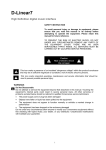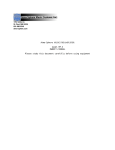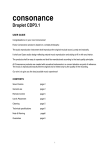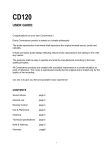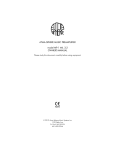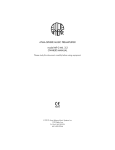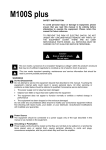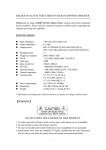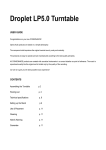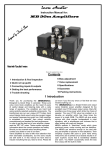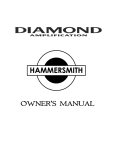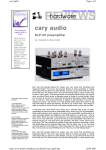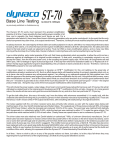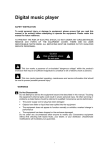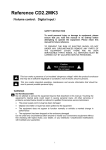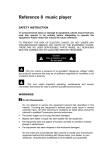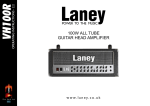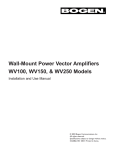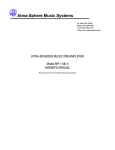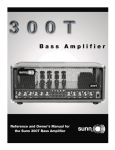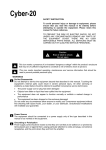Download Opera-Consonance CYBER-100S Signature
Transcript
Cyber-100S signature READ ENTIRE INSTRUCTION MANUAL BEFORE USING 1. SAFETY INSTRUCTION Read Instructions-All safety and operating instructions should be read before the amplifier is operated Retain Instructions -Safety and operating instructions should be retained for future reference. Heed warnings-All warnings on the amplifier and in the operating should be adhered to. Follow instructions-All operating and use instructions should be followed. Water and moisture-The equipment should not be used near water, e.g., near a bathtub, washbowl, kitchen sink, laundry tub, in a wet basement, or near a swimming pool etc. Ventilation-The equipment should be situated so that its location or position does not interfere with its proper ventilation. So the equipment should not be situated on a bed, sofa, or similar surface, e.g., that may block the ventilation openings, or placed in a built-in installation, such as a bookcase or cabinet that may impede the flow of air. The equipment should be situated away from heat sources such as radiators, heat register, stoves, or other electronic appliances that produce heat, so it may not suitable for commercial use. Power sources-The equipment should be connected to a power supply only of the type described in this manual or as marked on the equipment. Grounding or polarization-Power-supply cords should be routed so that they are not likely to be walked on or pinched by items placed upon or against them, paying particular attention to cords and plugs, convenience receptacles, and the point where they exit from the amplifier. Power lines-In case of connecting a tuner, an outdoor antenna should be located away from power lines. If an outside antenna is connected to the system, be sure the antenna is grounded so as to provide some protection against voltage surges and built up static charges. Any Servicing-The user should not attempt to service the equipment r beyond that described in this manual. All other servicing should be referred to qualified service technicians CAUTION: TO PREVENT THE RISK OF ELECTRIC SHOCK, DO NOT REMOVE COVER (OR BACK). NO USERSERVICEABLE PARTS INSIDE. REFER SERVICING TO QUALIFIED SERVICE PERSONNEL. The lightning flash with arrowhead symbol, within an equilateral triangle, is intended to alert the user to the presence of uninsulated“dangerous voltage”within the product's enclosure that may be of sufficient magnitude to constitute a risk of electric shock to persons. The exclamation point within an equilateral triangle is intended to alert the to the presence of important operating and maintenance (servicing) instructions in the literature accompanying the appliance. Congratulations! Opera Audio welcomes you to the growing number of discerning audiophiles who own Opera audio products. This manual has been prepared to help you to maximize your enjoyment of the performance and features of your new Consonance equipment. Please study this manual carefully and become acquainted with all the features, operation and capabilities of your new Consonance equipment. Should you have any questions, or desire information on other Opera audio products, please contact your local Opera dealer. 1 2. WHEN YOU OPEN THE BOX Before any Opera audio product leaves the factory it is carefully inspected for physical imperfections as a routine part of Opera audio's systematic quality control. After you have unpacked the equipment, inspect it for any physical damage. Save the shipping carton and all packing materials, because they are essential to reduce the possibility of transportation damage. Because some heat is generated by the equipment, adequate air circulation is provided to maintain cool operation. Leave enough space around the unit (at least 3 cm on the top and 3 cm on the sides and leave enough space on the back for the power card and interconnect cables). If the equipment is going to be mounted in an enclosed cabinet, it is recommended that the rear of the cabinet has vents to allow air to circulate around the unit. With these considerations implemented, the equipment should provide exceptional performance in any reasonable environment. Of course, such normal considerations as protection from excessive dust and moisture should always be observed. All the equipment made by Opera audio has been carefully designed with high quality components so that Long-term undiminished performance is operated in accordance with the instructions provided. 3. EQUIOMENT INSTALLATION AND GETTING STARTED Power-Cord, plugs and sockets The power cord should be routed so that it is not likely to be stepped on or pinched by items placed upon or against it. All the plugs and sockets supplied with your Consonance equipment have been chosen because they mark the best possible connection for their purpose. A poor contact will degrade the signal substantially and plugs and sockets should look clean and free from corrosion. The easiest way to clean them is to switch off the equipment, pull the plugs out of their sockets, and push them back in again. Special contact cleaners and contact enhancers should not be used as they tend to deposit a film which is very difficult to remove and may degrade the sound. Switching on and off Source components and power supplies for cd players, tuners, preamplifiers and crossovers should be switched on before switching on the amplifier(s). Always switch the amplifier(s) off and wait about 5 minute for its power supply capacitors to discharge before connecting or disconnecting any leads. Always use the power switch on the produce rather than a mains outlet switch. Running in Your Consonance equipment will take a considerable time to run-in before it performs at its best. The duration varies, but under some conditions you will find that the sound continues to improve for as much as five weeks. Better and more consistent performance will be achieved if the system is left switched on for long periods. It is worth remembering however that all electronic equipment can be damaged by lightning. Please read the warnings sectio Power supply Where fused plugs are used various amp fuses should be fitted . Fuses of a lower rating will fail after a period of use. A hi-fi system usually shares a main circuit with other household equipment some of which can cause distortion of the mains waveform. In some Consonance equipment such distortion can lead to a mechanical hum from the transformers. The hum is not transmitted through the speakers and has no effect on the performance of the system but is purely local to the transformer itself. A separate fused mains circuit (like that reserved for electric cookers) will also have a lower impedance, supply cleaner power, and consequently improve system performance. Do not wire voltage dependent resistors or noise suppressors into mains plugs. They degrade the mains supply and the sound. Locating the equipment Power supplies and amplifiers should be located a reasonable distance away from other equipment. This separation will stop transformer reasonable causing hum audible from the loudspeakers. The minimum recommended distance is 300mm (12 inches), and that allowed by the standard interconnect lead is the maximum. Some Consonance equipment is extremely heavy. Ensure than your equipment rack or table can easily support the weight and is stable. Cables, connections and speaker Impedance Loudspeaker leads are also very important leads to suit your equipment installation. The leads should each be at least 3.5 meters long and of equal length. The recommended maximum is 20 meters. The loudspeaker connectors supplied with all Consonance amplifiers and loudspeakers have been specifically designed to make a tight mechanical connection. It is essential that these are used in order to comply with local safety regulations. 2 For best performance, the load presented by the speaker has to match the amplifier's output impedance. Refer to the manufacture's information for your speaker nominal impedance. All the vacuum tube amplifier made by Opera audio are factory set to match the speakers at 8 ohms and 4 ohms. If you have a problem Legal consumer protection varies from country to country. A problem may be due to a fault in any part of the system or its installation so it is essential to make full use of your local dealer’s diagnostic skills on site. Please contact your local distributor, or Opera Audio at the address in the back of this manual, if any difficulties cannot be resolved. Some Consonance equipment is made in special versions for different territories and this makes it impracticable to arrange international guarantees. Please establish the guarantee arrangements with your own dealer at the time of sale. We are always available to offer help and advice. It is essential that repairs and updates are only carried out by an authorized Consonance dealer, or at the factory by Opera Audio itself. Many components are made, tested or matched specially for Consonance and appropriate replacements are often unobtainable from non-specialist sources. The equipment should be serviced by opera audio company or any qualified service personnel when: –The Power-supply cord or plug has been damaged. –Objects have fallen or liquid has been spilled into the equipment. –The equipment does not appear to act normally or exhibits a marked change in performance. –The equipment has been dropped or the enclosure damaged. Our dealer will have all relevant information about the service in your area and will ensure that you unit is serviced without delay. If for some reason, there are no service facilities available in your area, please ship the equipment to the following address: The Opera Audio Co., Ltd. NO.2 JiuXianQiaoLu Chaoyang District, Beijing, China Post Code: 100015, Tel: 86 10 64377091, Fax: 86 10 64377465 Email: [email protected] ,Website: www.operaudio.com You are responsible for all shipping charges, insurance, re-importation to your country, and duty arrangements. When shipping a product to factory for service, always include the following: –A sales slip or other proof of purchase if repair is claimed under warranty. –A proforma invoice with value of the goods, stating that the amplifier is returned to china for repair. –An accompanying letter describing faults, symptoms or problems with the amplifier. –Always ship the amplifier in its original carton and packaging material to prevent damage in transit. The Opera Audio will not accept responsibility for any damage caused in transit, no matter whatever caused. Warnings Consonance equipment is designed to offer the finest sound quality that can be achieved, avoiding compromise wherever possible. This can lead to circumstances that may be unfamiliar. The material that follows contains advice specifically related to Consonance equipment as well as more general warning about the use of domestic audio products. Please read it carefully. The transformers in Consonance power amplifiers and power supplies may sometimes make a mechanical noise caused by distortion of the mains waveform. Consonance transformers are large in size and have heavy gauge secondary windings making them relatively sensitive to such distortion. A separate mains circuit for your hi-fi system may reduce the effect while also giving an overall improvement in sound quality. It may be necessary however to take account of mechanical transformer noise when placing your equipment. In some circumstances, depending on where you live and the grounding arrangements in your home, you may experience radio frequency interference. Controls on broadcasting in some territories allow very high levers of radio frequency radiation and both the choice and exact place of equipment may be critical. If there is a known problem in your locality it is advisable to arrange for a home demonstration before purchase to find out if Consonance equipment 3 is likely to be affected. Susceptibility to radio frequency interference is related to the wide internal bandwidth necessary for high sound quality. Systems incorporating moving coil phono preamplifiers and active crossovers are more likely to suffer. Your Consonance hi-fi system can be damaged by lightning. Power amplifiers are particularly at risk and should be turned off when there is risk of lightning strike. For complete protection all mains plugs and any aerial cables should be disconnected when not in use. Equipment must not be exposed to dripping or splashing and no objects filled with liquid, such as vases, should be placed on the equipment. Important Do not under any circumstances allow anyone to modify your Consonance equipment without first checking with the factory, your dealer, or your distributor. Unauthorized modifications will invalidate your guarantee. For your own safety do not under any circumstances open Consonance equipment without first disconnecting the mains. Warning : Danger of electric shock and burns. Keep the unit away from rain or moisture. Do not attempt any of the instructions in this manual unless the unit has been unplugged for at least 10 minutes. If after reading the entire manual you feel any of the operations listed below is beyond your ability, please seek qualified technical assistance. UNPACKING & SET-UP 1. Check shipping package for sign of improper handling. Remove unit from plastic bag and inspect for damage. 2. AC Power connection 240V / 230V / 220V / 115V / 100V AC dependent on country. 3. Locate the 300B, 6SN7 and 12AX7 vacuum tubes and insert them into their sockets according to the number on base of tubes. Use the top chassis drawing for socket location and proper tube orientation. Be sure to hold the tube by its base when inserting and removing. This will minimize the chance of breaking the glue between the socket and the glass. 4. Place the unit away from heat source and allow for air flowing under and around the chassis. 5. Connect the input source to the amplifier’s right and left channel RCA jacks. Refer to rear chassis drawing. These jacks are labeled with colored washers: red for right and black for left. 6. Connect the speaker cables. Refer to rear chassis drawing for speaker connector location. Be sure the positive speaker lead is connected to the plus symbol on the speaker connector (In this case, red to red, black to black) Note: Never turn the amplifier on unless there are speakers connected to both output terminals. Operation of the amplifier without a load can damage the output transformers. FUNCTION 1. Power switch 2. Input select switch 3. Input select switch LED 4. Remote control window 5. Volume control 6. Input jacks (red / black). Line out 7,8 Speaker connector 9. Power plug WHAT TO DO IF … Power indicator and filaments do not light: Check the fuse and make sure the amplifier is plugged into a working power outlet. Sound out of one speaker only: 4 Turn volume control fully counter-clockwise and reverse input connectors. If sound changes from one speaker to the other, check source or replace inter-connect wires. If the sound is still coming out of the same speaker only, check speakers on another piece of equipment for proper operation. Static, noise, or hum: Turn the potentiometers Individually clockwise/counter-clockwise until hum goes to the lowest level each channel. DAMAGE REQUIRING SERVICE The amplifier should be serviced by opera audio company or any qualified service personnel when: The Power-supply cord or plug has been damaged. Objects have fallen or liquid has been spilled into the amplifier. The amplifier does not appear to act normally or exhibits a marked change in performance. The amplifier has been dropped or the enclosure damaged. Power-Cord The power cord should be routed so that it is not likely to be stepped on or pinched by items placed upon or against it. Cleaning Dust periodically with a clean, soft paint brush. Fingerprints can be removed with a moist polishing cloth. Never clean with furniture polish, benzene, or volatile liquids. Speaker Impedance For best performance, the load presented by the speaker has to match the M100Splus’s output impedance per channel. Refer to the manufacture’s information for your speaker nominal impedance. The M100Splus is factory set to match the speakers at 8 ohms and 4 ohms. THEORY OF OPERATION The cyber100S is a push-pull Class A integrated amplifier with little global feedback. The Ip of 300B is factory set at 60mA. Signal goes first to the 12AX7 dual triodes which act as input stage and then to the 6SN7s dual triodes which act as drive stage. The 6SN7 drive the 300B output tubes, one matched pair per channel. The 300Bs are transformercoupled to the load (In this case, the speaker). TECHNICAL SPECIFICATION CONTROL FUNCTIONS: Volume, Select, Power On/Off POWER OUTPUT: 22 watt x 2, RMS 1kHz TOTAL HARMONIC DISTORTION: less than 1%(10watt, 1kHz) FREQUENCY RESPONSE: (-3dB points at 10 watt) 8Hz-60kHz INPUT SENSITIVITY: 230mV INPUT IMPEDANCE:100k ohms OUTPUT IMPEDANCE: 4, 8 ohms. (User selectable.) SIGNAL/NOISE: 90dB CONSUMPTION: 120watt INPUT INTERFACES: 5 groups (RCA) 1,2,3,4,5 INPUT INTERFACES: 1 groups (RCA) OVERALL NEGATIVE FEEDBACK: Little VACUUM TUBE: 300B x 4,12AX7 x 2, 6SN7 x 2 DIMENSIONS: 430 ( L ) x380 ( W ) x 190( H ) mm WEIGHT: 25kg ( packed ) SPECIFICATIONS SUBJECT TO CHANGE WITHOUT NOTICE. USING TUBES 5 A. Bias Bias is a negative voltage applied to a power tube's control grid, to set the amount of idle current the tube draws. It is important to bias a tube to stay within its rated dissipation. Otherwise, you DO NOT need to worry about small deviances from the manufacturer's recommendations. Many times we have customers asking us things like, "I replaced the tubes, the old tubes ran at 35 mA, the new ones run at 38 mA. I'm worried that I have to rebias the amp." This is NOT worth worrying about. Anyway many consonance amps have bias adjustments. In that case, rebiasing is necessary. And some of them are designed so that you do not need to concern yourself with bias. This includes all self sustained single-ended triode hi-fi amps. B. When should I replace the tubes? Practically speaking, you should only replace tubes in an audio amplifier when you start to notice changes in the sound quality. Usually the tone will become "dull", and transients will seem to be blunted. Also, the gain of the amplifier will decrease noticeably. This is usually enough of a warning for tube replacement. C. Blue Glow -- what causes it? Glass tubes have visible glow inside them. Most audio types use oxide-coated cathodes, which glow a cheery warm orange color. And thoriated-filament tubes show both a white-hot glow from their filaments and (in some amplifiers) a slight orange glow from their plates. All of these are normal effects. Some newcomers to the tube-audio world have also noticed that some of their tubes emit a bluish-colored glow. There are TWO causes for this glow in audio power tubes; one of them is normal and harmless, the other occurs only in a bad audio tube. 1) Most glass power tubes show FLUORESCENCE GLOW. This is a very deep blue color. It can appear wherever the electrons from the cathode can strike a solid object. It is caused by minor impurities, such as cobalt, in the object. The fast-moving electrons strike the impurity molecules, excite them, and produce photons of light of a characteristic color. This is usually observed on the interior of the plate, on the surface of the mica spacers, or on the inside of the glass envelope. THIS GLOW IS HARMLESS. It is normal and does not indicate a tube failure. Enjoy it. Many people feel it improves the appearance of the tube while in operation. 2) Occasionally a tube will develop a small leak. When air gets into the tube, AND when the high plate voltage is applied, the air molecules can ionize. The glow of ionized air is quite different from the fluorescence glow above-ionized air is a strong purple color, almost pink. This color usually appears INSIDE the plate of the tube (though not always). It does not cling to surfaces, like fluorescence, but appears in the spaces BETWEEN elements. A tube showing this glow should be replaced right away, since the gas can cause the plate current to run away and (possibly) damage the amplifier. D. What is Class A, B, AB, ultralinear, etc? 1. Class A means that the power tube conducts the same amount of current all the time, whether idling or producing full power. Class A is very inefficient with electricity but usually gives very low distortion. There are single-ended class-A, or SE, amplifiers. They use one or more tubes in parallel, which are all in phase with each other. This is commonly used in smaller guitar amps and in exotic high-end amplifiers. Many audiophiles prefer the SE amplifier, even though it has relatively high levels of even-order distortion. Most 300B high-end amplifiers are SE. Negative feedback, which can be used to decrease the distortion of an amplifier, is felt by some people to sound inferior. Most SE amps have no feedback. Push-pull class-A amplifiers also exist--they use two, four or more tubes (always in pairs) which are driven in opposite phase to each other. This cancels out the even-order distortion and gives very clean sound. An example of a class-A push-pull amplifier is the M100S. Push-pull Class A operation usually involves low plate voltages and high plate currents, compared to Class AB operation below. The high currents might tend to wear out the tube cathodes faster than in an AB amplifier. 2. Class AB applies only to push-pull amplifiers. It means that when one tube's grid is driven until its plate current cuts off (stops) completely, the other tube takes over and handles the power output. This gives greater efficiency than Class A. It also results in increased distortion, unless the amplifier is carefully designed and uses some negative feedback. 6 3. Class B applies only to push-pull amplifiers in audio; it SOMETIMES applies to RF power amplifiers with one tube. It is like Class AB, except that the tubes idle at or near zero current. This gives even greater efficiency than Class A or AB. It also results in increased distortion, unless the amplifier is carefully designed and uses some negative feedback. If careful design is not undertaken, the result may be crossover distortion, which appears at the midpoint of the output waveform and has very bad-sounding effects in audio. Most solid-state audio amplifiers use class B, because the transistors undergo less heat stress when idling. 4. Ultralinear operation was invented by David Hafler and Herbert Keroes in 1951. It uses only beam tetrodes or pentodes, and special taps on the output transformer. The taps connect to the screen grids of the tubes, causing the screens to be driven with part of the output signal. This lowers distortion considerably. It is usually seen only in hi-fi amplifiers that use power tubes such as the 6L6, 6550, EL84 or EL34. E. Why are different kinds of power supplies used in various tube amplifiers? Why do some use tube amplifiers? Why do some use tube rectifiers, while others use solid-state rectifiers, while still others have electronic regulation? Tube rectifiers are still used in power supplies of some hi-end amps, because the current a tube rectifier can produce varies somewhat with the load. It is quite different in response from a solid-state rectifier. Many audiophiles also prefer this classic design for much the same reasons. Also, inexpensive solid-state rectifiers can put "hash" into a power supply, because of their slow transient capability while charging and recharging a filter capacitor 50/60 times a second. Special high-speed silicon rectifiers are available at high cost. They are rarely used in products other than a few highend amplifiers. Tube rectifiers have faster transient response than most solid-state rectifiers, also making them useful in some high-end designs. Regulated DC plate power can be very helpful in a push-pull Class AB amplifier. Because the amp draws greatly different current when at idle and when delivering full power, a regulated supply "sags" less at full power, producing better transient response in the amplifier. It is expensive to regulate the high voltages in a tube amplifier, so it is done only in expensive top-line models. Class A amplifiers have less need for regulation since they draw nearly the same DC power at all times. It is dependent on the circuit design. The only way to see if you need an amplifier with a regulated supply is to listen to it and carefully compare it with similar amps with unregulated supplies. F. There's all this talk about "parallel feed", "shunt feed", SRPP, "mu followers", and the like. Which should I use? What's the difference? Parallel feed and shunt feed are the same technique. Basically, a choke is used to load the power tube (usually one, in SE mode), while the output transformer is coupled to the plate of the tube through a capacitor. So, the plate current of the tube does not flow through the output transformer. This can be a very expensive technique to implement, since the choke must be as carefully wound as the output transformer. It does offer a possible performance improvement. SRPP circuits and mu-follower circuits are special designs which use a lower tube (for gain), and an upper tube which serves as the plate load for the lower tube. The upper tube also acts as both a cathode follower and as a constantcurrent source for the lower tube. If properly designed, either circuit can offer improved performance over an ordinary resistor-loaded tube stage. These circuits are used only in preamp stages and in the driver stages of power amps, usually SE types, in high-end audio. If you want to learn more of the technical details behind vacuum-tube electronic design, we recommend the following books. We recommend two recently-published books on circuit design, which the novice can derive much information from: THE BEGINNER'S GUIDE TO TUBE AUDIO DESIGN, by Bruce Rozenblit (ISBN 1-882580-13-3); and PRINCIPLES OF POWER, by Kevin O'Connor (ISBN 0-9698-6081-1). 7 Warranty Opera audio guarantees each product manufactured by us to be free from defects in materials and workmanship under normal use. Our obligation under this warranty is limited to making good at our factory any part or parts thereof which shall, within 1 year after delivery to the original purchaser, be returned to us with transportation charges prepaid, and which an examination shall disclose to have been thus defective; this warranty being expressly in lieu of all other warranties expressed or implied and of all other obligations or liabilities on our part. This warranty shall not apply to any Opera audio product which shall have been repaired or altered outside of our factory in any way so as to affect its stability, nor which has been subject to misuse, negligence or accident. Warranties of the vacuum tubes are by the respective manufacturers, usually 90 days. Please mail or e-mail the Registration Card to the address as follow: The Opera Audio Co., Ltd. No.2 JianXianQiaoLu ChaoYang District Beijing, China Tel: 86 10 64377091 Fax: 86 10 64377465 [email protected] www.operaudio.com Registration Card Name Address City State Zip Email Telephone Model Serial Number Purchase Date Dealer 8









